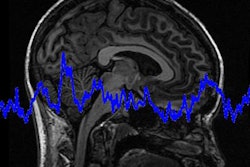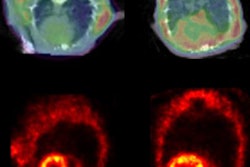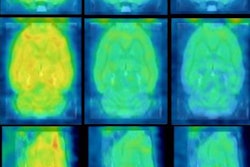
With projections that the number of people living with Alzheimer's disease in the U.S. could more than triple by the year 2050, 65 research institutions are collaborating on a clinical trial using PET scans to identify the disease in its earliest stages, as well as guide the use of potential therapeutic agents.
The Anti-Amyloid Treatment in Asymptomatic Alzheimer's (A4) study is enrolling 1,000 subjects who have normal memory and cognitive function but also show elevated levels of amyloid plaque in their brains. By using PET to detect the protein and treat it with an investigational drug, the hope is that more people can be spared from dementia and Alzheimer's.
"These are individuals we would consider to have preclinical Alzheimer's disease," said Dr. David Geldmacher from the University of Alabama at Birmingham (UAB), one of the sites involved in the A4 study. "The intent is to take these well people who have evidence of amyloid through the pathology in their brain and keep them well."
Alzheimer's trajectory
The Alzheimer's Association estimates that 16 million people in the U.S. could be living with the disease by the middle of this century, compared with some 5 million people who have Alzheimer's today. Costs related to treating people with Alzheimer's and other dementias could rise to $1.1 trillion by 2025, compared with $259 billion in 2017, according to the organization.
 Dr. David Geldmacher from the University of Alabama at Birmingham.
Dr. David Geldmacher from the University of Alabama at Birmingham."We know that the economics of the disease are foreboding," Geldmacher said. "Our current healthcare structure cannot afford the costs of that kind of care unless we find something meaningfully preventative or reduce the burden of the illness on our people who care for the individuals with the illness."
UAB's Alzheimer's research began in the 1990s and expanded over the past decade with the arrival of Dr. Erik Roberson, PhD, a professor of neurology at UAB, in 2008 and Geldmacher in 2011. Currently, UAB researchers are involved seven Alzheimer's-related clinical trials.
Three years ago, UAB opened its advanced imaging facility, which features a new T24 cyclotron to produce PET and SPECT radiotracers. It is the most powerful cyclotron at any academic medical center in the U.S., according to the university.
"That [cyclotron] opened the door for us to take many more creative approaches to Alzheimer's research, particularly those using PET imaging," said Geldmacher, who serves as director of the division of memory disorders in UAB's department of neurology.
So far, UAB has enrolled 10 people as part of its contribution to the A4 study. The key prerequisite for enrollment is the presence on PET scans of elevated levels of amyloid plaque in subjects who otherwise have no signs of dementia, Alzheimer's, or abnormal memory and cognitive issues. Amyloid deposition has been noted as an indicator of possible dementia and Alzheimer's progression.
The majority of the subjects at UAB have a vested interest in Alzheimer's prevention because of a family member who has had the illness.
"A large majority, if not all of our patients, have a first-degree relative who has experienced Alzheimer's or died of Alzheimer's, or something that is suspected of being Alzheimer's," Geldmacher said. "So people's motivations are not just the altruism of participating in the study to enhance knowledge, but also to seek knowledge and potentially care for their own risks for the illness."
Evaluation process
As part of the A4 study, UAB researchers will perform detailed assessments of the subjects' memory and cognitive performance and conduct PET scans using the radiotracer florbetapir, which binds to amyloid deposits in the brain. Florbetapir is marketed under the trade name Amyvid in the U.S. and Europe by Eli Lilly and its subsidiary Avid Radiopharmaceuticals.
Florbetapir-PET scans detect the buildup of amyloid before Alzheimer's starts to manifest, rather than assessing the downstream anatomic consequences of the disease, Geldmacher explained. This can give it an edge over other brain imaging tools such as MRI.
"MRI is a very powerful tool and it is the gold standard in detecting damage in the brain from Alzheimer's disease, but it is not capable of detecting the disease process before there is neuronal loss or atrophy," he said. "PET scans allow us to turn back the clock and find the molecular signals of the disease process prior to the loss of neurons and the atrophy that accompanies that."
Eli Lilly has made available at no cost to A4 researchers both florbetapir and its amyloid-fighting investigational drug known as solanezumab. Solanezumab is also designed to bind to amyloid, but its additional function is to help the body rid itself of the amyloid protein. The company is also supporting the A4 study through grants, making Eli Lilly the major funding source for the trial.
Subjects will be randomly assigned to receive either solanezumab or placebo, and they will be required to visit the UAB clinical research site once a month. Over the next three years, the researchers will follow the subjects to determine if the medication can remove or control amyloid in the brain, and if the treatment will prevent or reduce the risk of progression from this preclinical stage into symptomatic memory issues.
"Remembering that people entering the A4 study have no cognitive symptoms and no measurable deficits in their neuropsychological examination, our primary outcomes are the biomarkers like amyloid in the PET scan, and the conversion rate from the asymptomatic state to a symptomatic state of memory impairment or changes in the neuropsychological testing," Geldmacher said.
So far, so good
Geldmacher said the early stages of UAB's participation in the A4 study have gone well. He and his colleagues are "very pleased" with the enrollment, which continues, and the commitment from the community.
"I can say that our local cohort is tolerating treatments well, and thus far it has been a very good experience for them," he said. "I think they are reassured that even though we don't know if this treatment works, they are giving themselves the opportunity to receive potentially valuable treatment long before it would reach general commercial use."
To further its Alzheimer's research and outreach to the community, UAB three years ago launched its Alzheimer's Risk Assessment and Intervention Clinic. One program offers detailed cognitive exams, an Alzheimer's risk factor analysis, and MRI scans for people concerned about the disease.
Approximately 50 people have taken advantage of the service. Unfortunately, conventional health insurance does not pay for it, so people must pay out of pocket.
"We are able to help them identify reversible risk factors and things they might do to prevent or reduce their individual risk for Alzheimer's disease," Geldmacher said. "Those who have come have found it very helpful, and we can direct them to lifestyle modifications, such as weight loss and cholesterol management, that can help improve their risk of avoiding Alzheimer's disease."




















